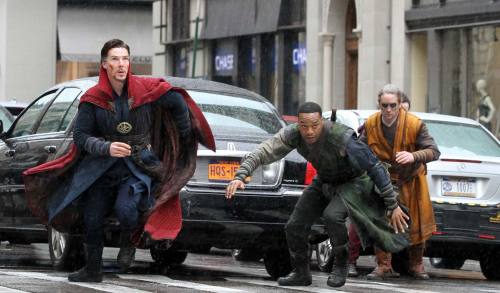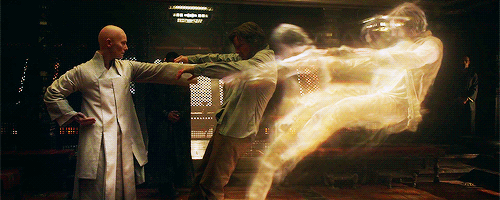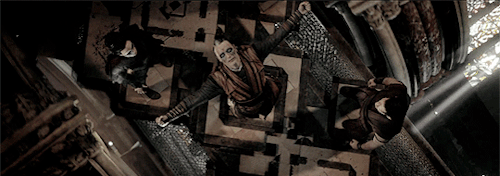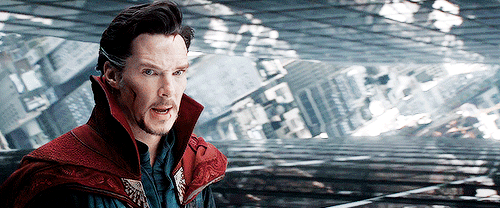“DOCTOR STRANGE” (2016) Review
Marvel Cinematic Universe (MCU) scored its first big box office hit of 2016 with the release of “CAPTAIN AMERICA: CIVIL WAR”. Six months later, the organization and producer Kevin Fiege scored another hit with its first adaptation of the Marvel Comics character, Doctor Strange.
Directed by Scott Derrickson and starring Benedict Cumberbatch in the starring role, “DOCTOR STRANGE” told unveiled the origin story of a successful New York City neurosurgeon named Dr. Stephen Strange, whose career ends when he loses the use of both hands in a traumatic car accident. Despite emotional support from his former lover and colleague Dr. Christine Palmer, Stephen vainly pursues one experimental surgery after another in the hopes of mending his hands, so that he can regain his medical career. When all else fails, he learns about a paraplegic who was mysteriously able to walk again named Jonathan Pangborn. The latter directs Stephen to a community in Tibet called Kamar-Taj.
Upon reaching the Tibetan city, Stephen meets a sorcerer named Karl Mordo. The latter recommends Strange as a potential student to his former mentor, a sorceress named The Ancient One. The latter displays her abilities with the mystic arts to Stephen, revealing the astral plane and other dimensions such as the Mirror Dimension. An amazed Strange begs her to teach him her abilities. The Ancient One reluctantly agrees, despite her wariness over his arrogance, which reminds her of a former student named Kaecilius. The latter and his new group of zealots had recently broke into Kamar-Taj secret compound, beheaded the librarian and stolen a secret ritual from a book that belonged to the Ancient One. With this stolen ritual, Kaecilius hopes to learn the means to acquire the power of eternal life. And it is up to The Ancient One, Mordo, the new librarian Wong and Stephen to stop him.
Superficially, “DOCTOR STRANGE” proved to be a different kettle of fish for Marvel. One, due to the abilities of the main protagonist and other supporting characters, this movie marked the MCU’s first foray into magic. Well … not really. The two previous “THOR” more or less stated that at least two of its characters practiced magic. But the subject of magic was never fully explored until “DOCTOR STRANGE”. Also, the movie marked the first time in which the main character practiced magic. Second, the method in which Stephen defeated the main antagonist’s goals did not rely upon violence of any kind. Our magical hero basically resorted to magic and cunning to win the day. To be honest, I cannot recall any other Marvel hero or heroine who did not resort to brute force to defeat any of the main villains in the past thirteen films. And although the MCU movie had its share of unusual visual effects - especially 2015’s “ANT-MAN”, those for “DOCTOR STRANGE” has to be the most visually stunning effects I have ever seen in any Marvel film so far.
Marvel Cinematic Universe (MCU) scored its first big box office hit of 2016 with the release of “CAPTAIN AMERICA: CIVIL WAR”. Six months later, the organization and producer Kevin Fiege scored another hit with its first adaptation of the Marvel Comics character, Doctor Strange.
Directed by Scott Derrickson and starring Benedict Cumberbatch in the starring role, “DOCTOR STRANGE” told unveiled the origin story of a successful New York City neurosurgeon named Dr. Stephen Strange, whose career ends when he loses the use of both hands in a traumatic car accident. Despite emotional support from his former lover and colleague Dr. Christine Palmer, Stephen vainly pursues one experimental surgery after another in the hopes of mending his hands, so that he can regain his medical career. When all else fails, he learns about a paraplegic who was mysteriously able to walk again named Jonathan Pangborn. The latter directs Stephen to a community in Tibet called Kamar-Taj.
Upon reaching the Tibetan city, Stephen meets a sorcerer named Karl Mordo. The latter recommends Strange as a potential student to his former mentor, a sorceress named The Ancient One. The latter displays her abilities with the mystic arts to Stephen, revealing the astral plane and other dimensions such as the Mirror Dimension. An amazed Strange begs her to teach him her abilities. The Ancient One reluctantly agrees, despite her wariness over his arrogance, which reminds her of a former student named Kaecilius. The latter and his new group of zealots had recently broke into Kamar-Taj secret compound, beheaded the librarian and stolen a secret ritual from a book that belonged to the Ancient One. With this stolen ritual, Kaecilius hopes to learn the means to acquire the power of eternal life. And it is up to The Ancient One, Mordo, the new librarian Wong and Stephen to stop him.
Superficially, “DOCTOR STRANGE” proved to be a different kettle of fish for Marvel. One, due to the abilities of the main protagonist and other supporting characters, this movie marked the MCU’s first foray into magic. Well … not really. The two previous “THOR” more or less stated that at least two of its characters practiced magic. But the subject of magic was never fully explored until “DOCTOR STRANGE”. Also, the movie marked the first time in which the main character practiced magic. Second, the method in which Stephen defeated the main antagonist’s goals did not rely upon violence of any kind. Our magical hero basically resorted to magic and cunning to win the day. To be honest, I cannot recall any other Marvel hero or heroine who did not resort to brute force to defeat any of the main villains in the past thirteen films. And although the MCU movie had its share of unusual visual effects - especially 2015’s “ANT-MAN”, those for “DOCTOR STRANGE” has to be the most visually stunning effects I have ever seen in any Marvel film so far.
As for the narrative itself … well, it is not bad. Aside from the unorthodox manner in which Stephen defeated the villain(s), “DOCTOR STRANGE” seemed to be your typical, paint-by-the-numbers superhero origin story. And I noticed that the film borrowed a good deal from other movies. Considering Stephen’s arrogant and witty personality, the movie bears a strong resemblance to the 2008 film, “IRON MAN”. In fact, like Tony Stark, Stephen’s arrogance remains intact by the last reel. Also, some of the visual effects reminded me of those found in Christopher Nolan’s 2010 movie, “INCEPTION”. And one of the villains that Stephen has to defeat in the end, Dormammu, reminded me of the villain called Parallax from the 2011 D.C. Comics film, “THE GREEN LANTERN”. Perhaps the originality found in “DOCTOR STRANGE” is limited to the MCU movies.
Although the topic of magic allowed the special effects team to provide moviegoers with some astounding visuals, I must admit that I found the movie’s portryal of magic to be a little … well, limited. Most of the magic presented in “DOCTOR STRANGE” seemed to consist of jumping through portals - either from one spot on the Earth to the next or to another dimension. If the movie’s magic practitioners were not jumping through portals, they were utilzing magical objects like the red Mystical Cloak of Levitation from the New York City sanctum that attached itself to Stephen; and the Eye of Agamotto, a relic containing an Infinity Stone that can manipulate time - which Stephen had used against Dormammu in the final action scene. Only one spell had appeared in the movie - the one that Kaecilius used to summon Dormammu.
The movie’s narrative suffered from one major aspect - characterization. One, the story lacked a strong leading lady. I personally have nothing against Rachel McAdams as an actress. But it seemed obvious that director/screenwriter Scott Derrickson and his fellow writers, Jon Spaihts and C. Robert Cargill did not know what to do with the Christine Palmer character. She was there to simply there to comfort Stephen following his accident and tend to his wounds, later in the film. At least McAdams had more lines than fellow cast member, Michael Stuhlbarg. The latter portrayed fellow surgeon, Nicodemus West, who seemed to exist to receive caustic criticism and needling from Stephen. Otherwise … what on earth was he there for? I realize that Marvel has a history of wasting some of its supporting character, but … good grief! And then we have poor Mads Mikkelsen, who had the bad luck to be cast as one of the most badly written villains in the MCU franchise. The Danish actor portrayed The Ancient One’s former student, Kaecilius, who resented the Ancient One’s method for maintaining a long life and long to do the same … even if it meant threatening the world by summoning Dormammu, the inter-dimensional being responsible for his former mentor’s long life. That is basically Kaecilius’ goal - to extend his life. That is what his attacks on the Ancient One’s sanctums in different parts of the world were about. Quite frankly, I was not impressed and believe that Mikkelsen was wasted in the role. Two actors and an actress wasted in one film. I find this disturbing.
And then … we have Tilda Swinton in the role of “The Ancient One”. In the Marvel comics, the Ancient One was a Tibetan man. In the name of “diversity”, Marvel decided to re-write the character as a Celtic woman … and still have her located in Tibet. Hmmmmm. Mind you, Swinton gave a first-rate performance as the mysterious and somewhat ambiguous spiritual and magical leader. But … “whitewashing!”. Marvel committed a major act of whitewashing. It is not the first time. But this was the most obvious example, considering the arguments that Derrickson and his two co-writers Jon Spaihts and C. Robert Cargill used to excuse their changes. They had claimed that they wanted to avoid the stereotypical portrayal of Asians - namely the “Dr. Fu Manchu”, “Dragon Lady” or the “young Asian woman sex fetish” types - by re-writing the Ancient One role as a non-Asian. So, they cast Swinton in the role. Frankly, I did not buy the arguments. The filmmakers did NOT have to re-write the role as a Westerner in order to avoid the Asian stereotypes. Any good actor or actress of Asian descent worth his or her salt could have done wonders with the role without resorting to stereotypes. A good example would be James Hong and Victor Wong’s outstanding performances in the 1986 movie, “BIG TROUBLE IN LITTLE CHINA”. But if Marvel was that determined for Ms. Swinton to portray “The Ancient One”, they could have re-located the character’s main sanctum somewhere in Scotland, Ireland or Wales.
However, “DOCTOR STRANGE” did feature some interesting performances that I had enjoyed. Benedict Wong, who could have easily been cast in the role of “The Ancient One”, managed to give a subtle and wry performance as the Kamar-Taj Sanctum’s librarian, Wong, despite his minimal screen appearances. Benjamin Bratt gave a brief, but very memorable performance as Jonathan Pangborn, a paraplegic who learned how to heal himself under the tutelege of “The Ancient One”. The movie’s mid-credit sequence also featured an amusing appearance by Chris Hemsworth as Thor. I can only assume that this was Marvel’s way of introducing the next film featuring the “God of Thunder” and the fact that Cumberbatch’s Stephen Strange will be appearing in that film.
When “DOCTOR STRANGE” first hit the movie screens, many filmgoers had complained about his American accent. To be honest, Cumberbatch’s accent seemed to lack any traces of his British ancestry. But I thought his accent had a trans-Atlantic vibe that I found rather bland. I could not regard his performance as the imaginative, yet arrogant Dr. Stephen Strange as bland. Like Robert Downey Jr. before him, Cumberbatch managed to create a character that was both infuriating and likable. But I thought that Chiwetel Ejiofor’s portrayal of Karl Mordo, another sorcerer who was trained by the Ancient One, proved to be the most interesting one in the film. Ironically, there was no outcry over the Karl Mordo character being changed from an Eastern European to a person of African descent. Considering the difficulties that many non-white actors and actresses still face in acquiring work in the movie and television industries, I am not surprised. But the best thing about Ejiofor is how he transformed Karl from an amiable sorcerer with a deep faith in the practices taught to him by the Ancient One to a potentially dangerous fanatic who became embittered by the Ancient One and Stephen’s willingness to use magic to defy nature. It is a pity that his performance has not garner much notice, except by the Evening Standard British Film Awards.
Overall, “DOCTOR STRANGE” is a solid entry for the Marvel Cinematic Universe that featured decent direction by Scott Derrickson and solid performances from a cast led by Benedict Cumberbatch. But aside from the movie’s visual effects, I would not consider to be particularly mind-blowing. I also believe that the movie was hampered by some poor characterizations and a misguided casting choice for one particular character. Oh well, Marvel cannot always hit it out of the ballpark.
Although the topic of magic allowed the special effects team to provide moviegoers with some astounding visuals, I must admit that I found the movie’s portryal of magic to be a little … well, limited. Most of the magic presented in “DOCTOR STRANGE” seemed to consist of jumping through portals - either from one spot on the Earth to the next or to another dimension. If the movie’s magic practitioners were not jumping through portals, they were utilzing magical objects like the red Mystical Cloak of Levitation from the New York City sanctum that attached itself to Stephen; and the Eye of Agamotto, a relic containing an Infinity Stone that can manipulate time - which Stephen had used against Dormammu in the final action scene. Only one spell had appeared in the movie - the one that Kaecilius used to summon Dormammu.
The movie’s narrative suffered from one major aspect - characterization. One, the story lacked a strong leading lady. I personally have nothing against Rachel McAdams as an actress. But it seemed obvious that director/screenwriter Scott Derrickson and his fellow writers, Jon Spaihts and C. Robert Cargill did not know what to do with the Christine Palmer character. She was there to simply there to comfort Stephen following his accident and tend to his wounds, later in the film. At least McAdams had more lines than fellow cast member, Michael Stuhlbarg. The latter portrayed fellow surgeon, Nicodemus West, who seemed to exist to receive caustic criticism and needling from Stephen. Otherwise … what on earth was he there for? I realize that Marvel has a history of wasting some of its supporting character, but … good grief! And then we have poor Mads Mikkelsen, who had the bad luck to be cast as one of the most badly written villains in the MCU franchise. The Danish actor portrayed The Ancient One’s former student, Kaecilius, who resented the Ancient One’s method for maintaining a long life and long to do the same … even if it meant threatening the world by summoning Dormammu, the inter-dimensional being responsible for his former mentor’s long life. That is basically Kaecilius’ goal - to extend his life. That is what his attacks on the Ancient One’s sanctums in different parts of the world were about. Quite frankly, I was not impressed and believe that Mikkelsen was wasted in the role. Two actors and an actress wasted in one film. I find this disturbing.
And then … we have Tilda Swinton in the role of “The Ancient One”. In the Marvel comics, the Ancient One was a Tibetan man. In the name of “diversity”, Marvel decided to re-write the character as a Celtic woman … and still have her located in Tibet. Hmmmmm. Mind you, Swinton gave a first-rate performance as the mysterious and somewhat ambiguous spiritual and magical leader. But … “whitewashing!”. Marvel committed a major act of whitewashing. It is not the first time. But this was the most obvious example, considering the arguments that Derrickson and his two co-writers Jon Spaihts and C. Robert Cargill used to excuse their changes. They had claimed that they wanted to avoid the stereotypical portrayal of Asians - namely the “Dr. Fu Manchu”, “Dragon Lady” or the “young Asian woman sex fetish” types - by re-writing the Ancient One role as a non-Asian. So, they cast Swinton in the role. Frankly, I did not buy the arguments. The filmmakers did NOT have to re-write the role as a Westerner in order to avoid the Asian stereotypes. Any good actor or actress of Asian descent worth his or her salt could have done wonders with the role without resorting to stereotypes. A good example would be James Hong and Victor Wong’s outstanding performances in the 1986 movie, “BIG TROUBLE IN LITTLE CHINA”. But if Marvel was that determined for Ms. Swinton to portray “The Ancient One”, they could have re-located the character’s main sanctum somewhere in Scotland, Ireland or Wales.
However, “DOCTOR STRANGE” did feature some interesting performances that I had enjoyed. Benedict Wong, who could have easily been cast in the role of “The Ancient One”, managed to give a subtle and wry performance as the Kamar-Taj Sanctum’s librarian, Wong, despite his minimal screen appearances. Benjamin Bratt gave a brief, but very memorable performance as Jonathan Pangborn, a paraplegic who learned how to heal himself under the tutelege of “The Ancient One”. The movie’s mid-credit sequence also featured an amusing appearance by Chris Hemsworth as Thor. I can only assume that this was Marvel’s way of introducing the next film featuring the “God of Thunder” and the fact that Cumberbatch’s Stephen Strange will be appearing in that film.
When “DOCTOR STRANGE” first hit the movie screens, many filmgoers had complained about his American accent. To be honest, Cumberbatch’s accent seemed to lack any traces of his British ancestry. But I thought his accent had a trans-Atlantic vibe that I found rather bland. I could not regard his performance as the imaginative, yet arrogant Dr. Stephen Strange as bland. Like Robert Downey Jr. before him, Cumberbatch managed to create a character that was both infuriating and likable. But I thought that Chiwetel Ejiofor’s portrayal of Karl Mordo, another sorcerer who was trained by the Ancient One, proved to be the most interesting one in the film. Ironically, there was no outcry over the Karl Mordo character being changed from an Eastern European to a person of African descent. Considering the difficulties that many non-white actors and actresses still face in acquiring work in the movie and television industries, I am not surprised. But the best thing about Ejiofor is how he transformed Karl from an amiable sorcerer with a deep faith in the practices taught to him by the Ancient One to a potentially dangerous fanatic who became embittered by the Ancient One and Stephen’s willingness to use magic to defy nature. It is a pity that his performance has not garner much notice, except by the Evening Standard British Film Awards.
Overall, “DOCTOR STRANGE” is a solid entry for the Marvel Cinematic Universe that featured decent direction by Scott Derrickson and solid performances from a cast led by Benedict Cumberbatch. But aside from the movie’s visual effects, I would not consider to be particularly mind-blowing. I also believe that the movie was hampered by some poor characterizations and a misguided casting choice for one particular character. Oh well, Marvel cannot always hit it out of the ballpark.


































































